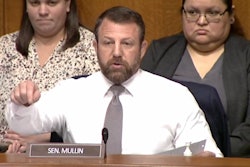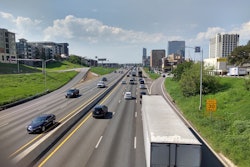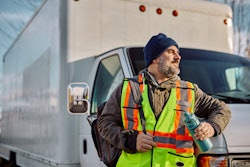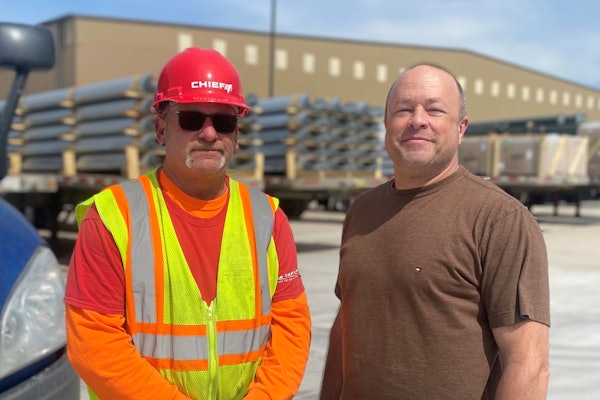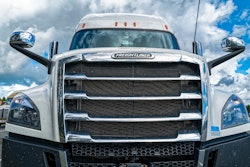Jason Cannon:
This week's 10-44 is brought to you by Chevron Delo 600 ADF ultra low ash diesel engine oil. It's time to kick some ash.
Are the robots coming for our jobs? Well, kind of, yeah. You're watching CCJ's 10-44, a weekly webisode that brings you the latest trucking industry news and updates from the editors of CCJ. Don't forget to subscribe and hit the bell for notifications so you'll never miss an installment of 10-44.
Hey everybody, welcome back and happy Black Friday. I'm Jason Cannon, and if he's not buried under a mountain of people Black Friday shopping at Walmart, on the other side, is Matt Cole.
Trucking's already down its path of automation, whether it's the use of technologies that help streamline logistics or things like autonomous trucks.
Matt Cole:
No, the robots aren't coming for your jobs, not all of them anyway. But we've been seeing trends for years in assembly plants, for example, that automation works alongside a reduced number of actual people.
Jason Cannon:
So what happens when things are fully automated? Robots don't need groceries. They don't buy cars and they don't contribute to the overall economy.
Well, joining the 10-44 this week is Dijam Panigrahi. He's the co-founder of California-based GridRaster, which is an AR VR tech platform for the automotive and aerospace segments. And he says this kind of workforce evolution has been ongoing for centuries. And as we look back in history, so look toward the future. There's going to be some good and there's going to be some bad.
Dijam Panigrahi:
This is a question that keeps on coming even centuries and centuries. I know this is a question that happened when the industrialization happened. Then the electrification happened. Then you had the computers that came in. And with every bit of technology progress, that we absolutely see the same question coming back.
But if you map out from when it started before all this question begin to happen, and today, it's still, the number of jobs have kind of increased.
The idea here is a lot of the part of the job, people are looking to kind of automate just because that's the best way to do it. Most likely, you will see that it's not that the jobs will get replaced, but the new jobs will get created as well in the process.
For example, when all this marketing social media stuff, all this thing came, a lot of that automation that is happening at the backend, but you now got people who need to manage the social media. There is a different profile of jobs that got created just because of the new technology that came in. It didn't go away.
First and foremost, from a workers' angle, you are getting, now, tools which makes your job and environment much safer. Things that are easier to do, less stressful on you.
From the owner's point of view, you are able to improve the productivity of it, which is basically you are able to bring down the cost flow. So you are basically trying to work out your economics over there.
And from a consumer perspective, you're going to get things better and maybe cheaper just because you're able to bring certain automation and reduce those costs.
So honestly, the entire ecosystem gains. I think it's just human that like any change, there is a little bit of resistance to the initial factors. But things will fall in place.
Matt Cole:
As we're seeing right now, there are plenty of jobs that companies can't get people to do, and others that aren't safe to do. Those kind of roles make them priority targets for automation because the robots don't care.
Dijam Panigrahi:
There are certain jobs, it's actually better off humans not doing it. For example, you are inspecting a hazardous material and you are actually sending in human to do that. That's not something that you really want them to expose to. Would you really want that to be automated and replaced by something which humans are not? Absolutely.
Then you have scenarios where it's a safety hazard. I know use cases where people in aerospace and defense, where we're working, or automotive, you get into spaces which is too congested, suffocating, and all of that. Maybe a robot goes, scan things up, gets things out, and using the immersive medium, you recreate that 3-D wall inspected outside, instead of that same person getting inside and doing what the person was doing inside those congested spaces. Now you're using a technology to capture all of that.
The same person, the expertise, still is needed to figure out what's right, what's wrong, where is the defect, where is the damage. Just that you made that job much easier.
So suddenly, during this automation process, a lot of this repetitive work, the job, which today still humans do, would go away. But the expertise, the things that it requires certain expertise in order to get things done, it's not going to go anywhere. All that they may change into is you are now doing with your hands, now you're basically maybe operating a robot to get certain things done. But the job is still there.
Jason Cannon:
Dijam says right now automation has emerged as an answer to a very important question. And he tells us what that answer is and what the question is, after a word from 10-44 sponsor Chevron Lubricants.
Protecting your diesel engine and its aftertreatment system has traditionally been a double-edged sword. The same engine oil that is so essential to protecting your engines internal parts is also responsible for 90% of the ash that is clogging up your DPF and upping your fuel and maintenance costs.
Outdated industry thinking still sees a trade-off between engine and emission system protection, and Chevron was tired of it. So they spent a decade of R&D developing a no-compromise formulation.
Chevron Lubricants developed a new ultra low ash diesel engine oil that is specifically designed to combat DPF ash clogging. Delo 600 ADF with Omnimax technology cuts sulfate ash by a whopping 60%, which reduces the rate of DPF clogging and extends DPF service life by two and a half times. And just think what you can do with all the MPGs you're going to add from cutting your number of [inaudible 00:06:26].
But Delo 600 ADF isn't just about aftertreatment. It provides complete protection, extending drain intervals by preventing oil breakdown. Before, you had to choose between protecting your engine or your aftertreatment system, and now you don't.
600 ADF from Delo with Omnimax technology. It's time to kick some ash.
Dijam Panigrahi:
It's not a question there is an oversupply of labor to do certain things. Actually, the fact is, on the manufacturing, there is actually short supply of labor that's needed to be done.
How do you close that gap, because the new generation is not ready to work in those environments anymore? So you have a new generation wants to go in a different direction. The number of people who are available is also not sufficient to provide the need that is there to the industry.
So one, is the part, so you're basically [inaudible 00:07:20], why the new age labor is not coming to this manufacturing and all that kind of space. Is it a case that, okay, it just sounds too difficult, too laborious? I mean, there is a lot of study that has happened around that.
And one of the key things that comes up is that can you make it much more safe? Because it's always an option. You have other options that are available. You can evaluate within the options you have. Can you make this a much more attractive option than what it is? It today looks heavily like you have to do a lot of manual stuff. You have to really be laborious. The payment not be that great compared to other options that may be available. So it's an obvious choice. People do it. Across centuries, that's been the case.
So first thing, obviously, automation helps as an industry. They still have to survive. The industry still has to go on, so automation helps in order to maybe close some of the gap that has been built out just because of the shortage of the labor supply, and you can do more with less now.
Matt Cole:
So how do you incentivize this next generation to take jobs alongside automation? Turns out it's pretty straightforward.
Dijam Panigrahi:
They're much more comfortable on the digital side. They have been using, maybe nowadays, the phones, like we hand out the phones to a one-year-old. So I mean, they have gone through that phase. They're so much more comfortable dealing with the digital thing, automating stuff.
So you're basically giving them an attractive option to come and say, "Okay, this is an extension of what you are doing, but now you are going to do in a much more organized setup, an industrial setup."
But you need to bring down those barriers. And this technology, like all this technology that we are talking about, whether it's an AI, whether we're talking about robotics or AR VR, are phenomenally coming together to facilitate some of that.
Augment the skillset. The idea here is can I augment the skillset of somebody who comes in at a certain scale, and how quickly can I get them to do certain things?
Absolutely, all this technology's phenomenal. You are able to reduce touch labor by 85% in some of the cases. You're able to train people almost at one sixth the time that it takes otherwise how you train. The numbers have been phenomenal. Honestly, the entire ecosystem gains out of it.
Jason Cannon:
In trucking, we're already seeing, in some cases, regulations hold back the deployment of technology. And Dijam says that has to be a give and take relationship.
Dijam Panigrahi:
The thing is, if you want to allow the technology to improve at a rapid speed, initially, I think you want to put less regulation burden in it. To incentivize all the innovation that really happens.
But after it reaches a certain stage, where you are thinking that impact is going to be at a much larger mass scale, that's where the regulation needs to make sure how quickly the technology impacts the larger mass, is cushioned with what I was talking about, that mental shift from a human point of view. Re-skilling, if it's a re-skilling thing. That's the role of the regulation to come in.
When you're talking about the different state, it'll be very interesting to also see, because I track it pretty closely. So you see the states which has actually allowed most of this autonomous stuff or have gone a little ahead from other states, you'll most likely see there is a shortage of those kinds of levers there.
Their need in those states for those kind of capabilities are much higher compared to the state where they are still regulating it, because maybe a larger portion of the labor still depends on that.
And I think that's the right way to go about it, because what you're trying to ensure, that you're giving enough. Because all that is about making sure the technology doesn't disrupt in a certain way, that the social structures get affected in a big way.
So that's where the regulation needs to cushion and the impact could be different in different state. It just makes sense to have those policies defined around that.
Jason Cannon:
That's it for this week's 10-44. You can read more on CCJDigital.com. While you're there, sign up for our newsletter and stay up to date on the latest in trucking industry news and trends. If you have any questions or feedback, please let us know in the comments below. Don't forget to subscribe and hit the bell for notifications so you can catch us again next week.

